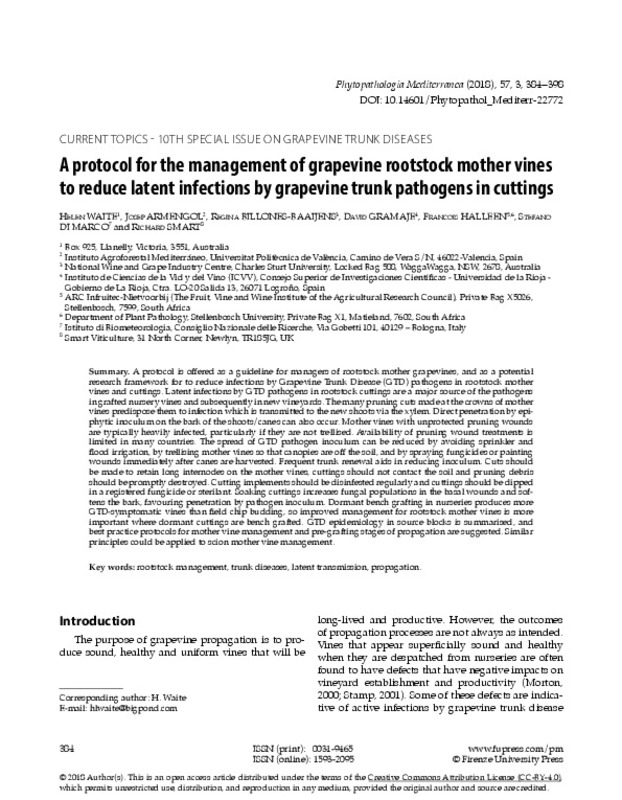JavaScript is disabled for your browser. Some features of this site may not work without it.
Buscar en RiuNet
Listar
Mi cuenta
Estadísticas
Ayuda RiuNet
Admin. UPV
A protocol for the management of grapevine rootstock mother vines to reduce latent infections by grapevine trunk pathogens in cuttings
Mostrar el registro sencillo del ítem
Ficheros en el ítem
| dc.contributor.author | Waite, H.
|
es_ES |
| dc.contributor.author | Armengol Fortí, Josep
|
es_ES |
| dc.contributor.author | Billones-Baaijens, R.
|
es_ES |
| dc.contributor.author | Gramaje Pérez, David
|
es_ES |
| dc.contributor.author | Halleen, F.
|
es_ES |
| dc.contributor.author | Di Marco, S.
|
es_ES |
| dc.contributor.author | Smart, R.
|
es_ES |
| dc.date.accessioned | 2019-09-21T20:02:54Z | |
| dc.date.available | 2019-09-21T20:02:54Z | |
| dc.date.issued | 2018 | es_ES |
| dc.identifier.issn | 0031-9465 | es_ES |
| dc.identifier.uri | http://hdl.handle.net/10251/126162 | |
| dc.description.abstract | [EN] A protocol is offered as a guideline for managers of rootstock mother grapevines, and as a potential research framework for to reduce infections by Grapevine Trunk Disease (GTD) pathogens in rootstock mother vines and cuttings. Latent infections by GTD pathogens in rootstock cuttings are a major source of the pathogens in grafted nursery vines and subsequently in new vineyards. The many pruning cuts made at the crowns of mother vines predispose them to infection which is transmitted to the new shoots via the xylem. Direct penetration by epiphytic inoculum on the bark of the shoots / canes can also occur. Mother vines with unprotected pruning wounds are typically heavily infected, particularly if they are not trellised. Availability of pruning wound treatments is limited in many countries. The spread of GTD pathogen inoculum can be reduced by avoiding sprinkler and flood irrigation, by trellising mother vines so that canopies are off the soil, and by spraying fungicides or painting wounds immediately after canes are harvested. Frequent trunk renewal aids in reducing inoculum. Cuts should be made to retain long internodes on the mother vines, cuttings should not contact the soil and pruning debris should be promptly destroyed. Cutting implements should be disinfested regularly and cuttings should be dipped in a registered fungicide or sterilant. Soaking cuttings increases fungal populations in the basal wounds and softens the bark, favouring penetration by pathogen inoculum. Dormant bench grafting in nurseries produces more GTD-symptomatic vines than field chip budding, so improved management for rootstock mother vines is more important where dormant cuttings are bench grafted. GTD epidemiology in source blocks is summarised, and best practice protocols for mother vine management and pre-grafting stages of propagation are suggested. Similar principles could be applied to scion mother vine management. | es_ES |
| dc.language | Inglés | es_ES |
| dc.publisher | MEDITERRANEAN PHYTOPATHOLOGICAL UNION | es_ES |
| dc.relation.ispartof | PHYTOPATHOLOGIA MEDITERRANEA | es_ES |
| dc.rights | Reconocimiento (by) | es_ES |
| dc.subject | Rootstock management | es_ES |
| dc.subject | Trunk diseases | es_ES |
| dc.subject | Latent transmission | es_ES |
| dc.subject | Propagation | es_ES |
| dc.subject.classification | PRODUCCION VEGETAL | es_ES |
| dc.title | A protocol for the management of grapevine rootstock mother vines to reduce latent infections by grapevine trunk pathogens in cuttings | es_ES |
| dc.type | Artículo | es_ES |
| dc.identifier.doi | 10.14601/Phytopathol_Mediterr-22772 | es_ES |
| dc.rights.accessRights | Abierto | es_ES |
| dc.contributor.affiliation | Universitat Politècnica de València. Departamento de Ecosistemas Agroforestales - Departament d'Ecosistemes Agroforestals | es_ES |
| dc.contributor.affiliation | Universitat Politècnica de València. Instituto Agroforestal Mediterráneo - Institut Agroforestal Mediterrani | es_ES |
| dc.description.bibliographicCitation | Waite, H.; Armengol Fortí, J.; Billones-Baaijens, R.; Gramaje Pérez, D.; Halleen, F.; Di Marco, S.; Smart, R. (2018). A protocol for the management of grapevine rootstock mother vines to reduce latent infections by grapevine trunk pathogens in cuttings. PHYTOPATHOLOGIA MEDITERRANEA. 57(3):384-398. https://doi.org/10.14601/Phytopathol_Mediterr-22772 | es_ES |
| dc.description.accrualMethod | S | es_ES |
| dc.relation.publisherversion | http://doi.org/10.14601/Phytopathol_Mediterr-22772 | es_ES |
| dc.description.upvformatpinicio | 384 | es_ES |
| dc.description.upvformatpfin | 398 | es_ES |
| dc.type.version | info:eu-repo/semantics/publishedVersion | es_ES |
| dc.description.volume | 57 | es_ES |
| dc.description.issue | 3 | es_ES |
| dc.relation.pasarela | S\383644 | es_ES |








